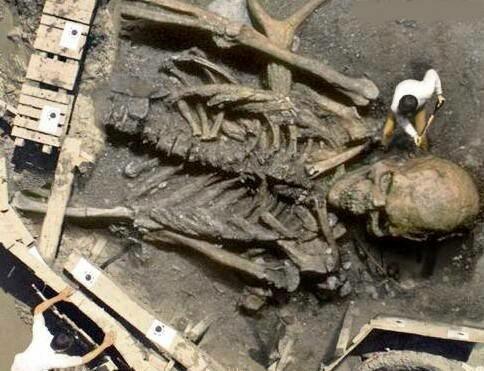The Sudan of today is ravaged by inter-ethnic violence and on the brink of a humanitarian disaster. Yet 200 millennia ago the area that is now Sudan was at the cutting edge of technological and cultural development, creating what some scholars believe was the world's oldest known piece of art.
Now the people of its successive kingdoms, who humbled the pharaohs of Egypt, fought to a draw the power of Rome and held off the might of the Muslim Arabs, are to be recognised in an exhibition at the British Museum.
Sudan is another of those interesting places (archaeologically) that no one knows anything about. There's a great deal of prehistoric archaeology there, and it was a significant player through much of Egyptian dynastic history. Check out this site for a review of recent expeditions and also some of the links at About.com's Nubia page.
More on the CT-scanned mummy Technology unravels new views of mummies
London's storied British Museum is shining a fresh light on a 3,000-year-old mummy, pointing to high-tech times ahead for the venerable world of Egyptology.
An ongoing museum exhibit, Mummy: The Inside Story, presents a 3-D look at the unopened mummy of Nesperennub, an ancient Egyptian priest. Using the latest in medical technology, visitors see under the mummy's wrappings and flesh, catching researchers' insights into the art that went into its creation.
And we are happy to report the creepy orange pictures of Nesperennub are back.

This is interesting Data links early settlers to African diaspora
Long before Portuguese sailors put "Formosa" on the world map, and long before Chinese people crossed the dark current to set up home here, this land was inhabited by Austronesian Aborigines for thousands of years. Multigenetic analysis reveals that Austronesian tribes arrived as early as 14,000 years ago.
According to Marie Lin, who conducted the research as director of the immunohematory reference laboratory at Mackay Memorial Hospital, the gene typology of Taiwan's twelve indigenous peoples suggests a close kinship with Southeast Asian islanders, another subgroup of the Austronesian language family. Lin also deduced that the central mountain tribes and east coast tribes might have different origins due to separate waves of immigration from Africa between 40,000 and 60,000 years ago.
Another case where the genetic and archaeological data are seemingly at odds.
Archeologists Unearth Pre-Historic Artifacts in Coastal Turkey
Excavations carried out since 1987 in the ancient city of Kelenderis in the Aydincik district of Mersin (a Southern Turkish city) turned up pre-historic artifacts for the first time this year.
Kelenderis Excavation Head and Selcuk University Archeology Department Professor Dr. Levent Zoroglu explained that while the ancient city of Kelenderis dates back to the 8th century B.C., archeologists digging at the site uncovered ceramic pieces that are almost 5,000 years old.
Antiquities Market update I DAS seizes a huge shipment of archeological pieces
DAS seizes a huge shipment of archeological pieces in the north of Bogotá
Almost two thousand pieces dated 200 d.c were hidden in a pre- Columbian art gallery
The archeological treasure was illegally unburied from pre - Columbian tombs in the central and south areas of the country. This treasure was being commercialized.
Antiquities Market update II Public Plunder of Jiroft Artifacts Resumes
In a public frenzy to unearth lucrative 5,000-year-old artifacts, Jiroft residents are plowing their yards and gardens, reminiscent of nasty scenes last seen three years ago.
The historical site of Jiroft, home to an ancient civilization, is dubbed as “archeologists’ paradise”, since it is one of the most artifact-rich sites in the globe. Three years ago, local people, who are mostly farmers and businessmen, lunched a artifact rush and smuggled some priceless relics out of Iran.
“This time around, according to local tip-offs, people have clandestinely started to dig out their houses’ yards and gardens in search of 5,000-year-old artifacts,” said Rahmatollah Raouf, commander of the National Cultural heritage Corps.
He said law enforcement forces could not sweep on all suspected houses and the only solution is to increase the public awareness. Raouf threatened perpetrators with jail sentences, however, if they do not stop plundering national artifacts.
In January 2001 a group of Iranians from Jiroft in the southwestern province of Kerman stumbled upon an ancient tomb. Inside they found a hoard of objects decorated with highly distinctive engravings of animals, mythological figures and architectural motifs.
They did not realize it at the time but they had just made one of the most remarkable archaeological discoveries of recent years, one that is radically altering accepted notions of the development of the world's earliest civilizations in Iran and Mesopotamia between the fourth and third millennia BC. A few weeks after the discovery, officials from Iran's Ministry of Culture, vastly outnumbered by local people, watched hopelessly as thousands systematically dug up the area. The locals set up a highly organized impromptu system to manage the looting: each family was allocated an equal plot of six square-meters to dig.
This organized pillaging continued for an entire year. Dozens of tombs were discovered, some containing up to 60 objects, and thousands of ancient objects were removed. All of these were destined for overseas markets.
In February 2002 Iran's Islamic police finally arrived in force to stop the destruction. Some 2,000 objects were confiscated from locals in Jiroft and other hoards of the ancient artifacts ready to be shipped overseas were seized in Tehran and at Bandar Abbas.
The objects confiscated by the police are unlike anything ever seen before by archeologists. Many are made from chlorite, a gray-green soft stone; others are in copper, bronze, terracotta, even lapis lazuli. They are now being studied by a group of Iranian archaeologists led by Dr. Madjidzadeh. Official excavation of the site began in February 2003. It is focusing on both the necropolis, which was looted extensively, and on an ancient settlement not discovered by the looters.
We provide the entire story here as the formatting of the web page is difficult to read.
Antiquities Market update III Lebanese antiquities dealers prosecuted in US and Egypt
Hicham Aboutaam, a Lebanese principal in the antiquities dealers Phoenix Ancient Art, of Geneva and New York, was sentenced on 20 July in Manhattan federal court to one year’s probation and a criminal fine of $5,000 for falsely representing that an antique silver drinking vessel, which he imported into the US and then sold through his gallery to a private collector, originated in Syria.
The silver vessel, decorated with a griffin and dated about 700 BC, was sold by Phoenix Ancient Art to a collector for $950,000, but it has now been seized by US authorities and is in the custody of the US Department of Homeland Security.
A sleeping giant lies under Afghan sands
Archaeologist Zemaryalai Tarzi can barely bring himself to look at the ravaged cliff face where two ancient Buddhas towered until the Taliban infamously blasted them to bits.
"For me, everything there is over," Tarzi says, pointing toward the heap of peach-colored dust and chunks of rock that used to be one of the massive statues. "It hurts my heart to go there and see what has been lost."
But the scientist, who began his career in the sleepy valley in Afghanistan's central highlands more than 35 years ago, isn't letting the destruction get the best of him. He has turned his back on the cliff, stuck his trowel in the earth and is on the hunt for a magnificent relic perhaps five times as large as the ones that incurred the Taliban's wrath: the long-lost sleeping Buddha of Bamian.
"We are digging," Tarzi says, "to find the greatest statue in the world."
Silly, he's already been found.

More lost
A Bronze Age cemetery is one of a number of prehistoric settlements that have been discovered in County Down.
Neolithic homes, which date to 4000 BC, were also uncovered by archaeologists along the A1 road near Newry.
Evidence from the excavation is being preserved before work begins on upgrading the road at Loughbrickland.
Head archaeologist Kevin Beachus said the find, which he described as "significant" was far more then his team expected.
Museum officials slobbering all over themselves Houston museum drooling at prospect of exhibiting famous 'Lucy' fossil
The first-ever public display of Lucy, a 3.2 million-year-old fossil discovered in Ethiopia, is scheduled for Houston in 2006, to the chagrin of some anthropologists who fear the project will harm the partial skeleton.
Ethiopia, the east African country where Lucy is stored in a museum safe, hopes to encourage tourism and investment by offering the treasure to the Houston Museum of Natural Science.
"Nobody is happy about exporting the original Lucy outside of Ethiopia," said Yohannes Haile-Selassie, a curator at the Cleveland Museum of Natural History. "People think the export might endanger Lucy."
We are unsure of what to make of this. On the one hand, of course one doesn't want the remains damaged (though that apparently wasn't an issue when they were shipped off with Johanson for study after their discovery). On the other hand, we can't imagine a better way to get the public's attention to things paleontological than the actual skeleton of one of the most significant hominids in history. So, we leave it up to you to decide.
BTW, Johanson's book on Lucy (Lucy: The Beginnings of Humankind) is an excellent read. Apparently, it pushed a lot of people into physical anthropology as a university major. Johanson's a good writer and this book is a good description of what fieldwork is like and how analysis of the skeleton was carried out.




